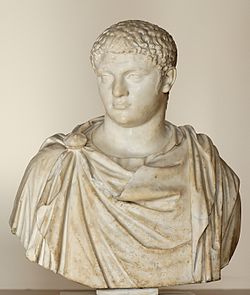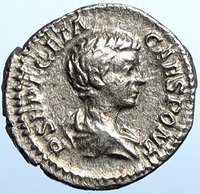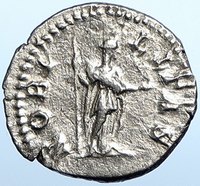Geta - Roman Emperor: 209-211 A.D.
as Caesar: 198-209 A.D. (under Septimius Severus and Caracalla)
Silver Denarius 18mm (2.92 grams) Rome mint, struck circa 200-205 A.D.
Reference: RIC IV 13a; RSC 90; Sear 7184; BMC 223
P SEPT GETA CAES PONT, bare-headed, draped bust right.
NOBILITAS, Nobilitas standing facing, head to right, holding scepter in her right hand and palladium in her left. You are bidding on the exact item pictured, provided with a Certificate of Authenticity and Lifetime Guarantee of Authenticity.
 Nobilitas, Roman goddess, as the embodiment (personification) of being "noble" or having "nobility". She is depicted on coins as a female figure standing at times with a lance in one hand and the palladium in the other. Valor in war and/or wisdom in council were ways by which nobility was or ought to be acquired. Nobilitas, Roman goddess, as the embodiment (personification) of being "noble" or having "nobility". She is depicted on coins as a female figure standing at times with a lance in one hand and the palladium in the other. Valor in war and/or wisdom in council were ways by which nobility was or ought to be acquired.
During the Roman Republic, nobilis ("noble," plural nobiles) was a descriptive term of social rank, usually indicating that a member of the family had achieved the consulship. Those who belonged to the hereditary patrician families were noble, but plebeians whose ancestors were consuls were also considered nobiles. The transition to nobilitas thus required the rise of an exceptional individual, who was considered a "new man" (novus homo). Two of the most famous examples of these self-made "new men" were Gaius Marius, who held the consulship seven times, and Marcus Tullius Cicero. The Second Samnite War (326-304 BC) was a formative time in the creation of this ruling elite comprising both patricians and plebeians who had risen to power. From the mid-4th century to the early 3rd century BC, several plebeian-patrician "tickets" for the consulship repeated joint terms, suggesting a deliberate political strategy of cooperation. Scholarly attempts to define nobilitas have led to debates over the particulars of its usage in ancient sources. Fergus Millar points out that nobilis was a descriptive word as used in the Late Republic, and not a technical term for a restricted social group in the sense of peerage. Matthias Gelzer held that the term was reserved for descendants of consuls, and therefore reckoned that Munatius Plancus, consul designate for 42, was the last man to qualify as an ancestor for a nobilis. P.A. Brunt, building on the view of Theodor Mommsen, assembled evidence of broader usage that suggests any curule office might grant the aura of nobilitas. The term is not found in the literature of the mid-Republic, and came into use long after the social and political changes that created "noble" plebeians. During the time of Augustus, a nobilis enjoyed easier access to the consulship, with a lowered age requirement perhaps set at 32. Women who descended from Augustan consuls are also regarded as belonging to the Roman nobility. In the usage of Tacitus and Pliny Minor, a nobilis is a descendant of the Republican aristocracy. The meaning of nobilis then evolved during the Imperial period.

| Caesar: 198-209 A.D. (under Septimius Severus and Caracalla) | Augustus: 209-211 A.D. (209-211 with Septimius Severus and Caracalla) (211 A.D. with Caracalla) | | Son of Septimius Severus and Julia Domna | Brother of Caracalla | Brother-in-law of Plautilla | Nephew of Julia Maesa | Cousin of Julia Soaemias and Julia Mamaea | Publius Septimius Geta (March 7, 189-December 26, 211), was a Roman Emperor co-ruling with his father Septimius Severus and his older brother Caracalla from 209 to his death. Geta was the younger son of Septimius Severus by his second wife Julia Domna. Geta was born in Rome, at a time when his father was only a provincial governor at the service of emperor Commodus. Geta was always in a place secondary to his older brother Lucius, the heir known as Caracalla. Perhaps due to this, the relations between the two were difficult from their early years. Conflicts were constant and often required the mediation of their mother. To appease his youngest son, Septimius Severus gave Geta the title of Augustus in 209. During the campaign against the Britons of the early 3rd century, the imperial propaganda publicized a happy family that shared the responsibilities of rule. Caracalla was his father's second in command, Julia Domna the trusted counsellor and Geta had administrative and bureaucratic duties. Truth was that the rivalry and antipathy between the brothers was far from being improved. Joint Emperor When Septimius Severus died in Eboracum in the beginning of 211, Caracalla and Geta were proclaimed joint emperors and returned to Rome. Regardless, the shared throne was not a success: the brothers argued about every decision, from law to political appointments. Later sources speculate about the desire of the two of splitting the empire in two halves. By the end of the year, the situation was unbearable. Caracalla tried to murder Geta during the festival of Saturnalia without success. Later in December he arranged a meeting with his brother in his mother's apartments, and had him murdered in her arms by centurions. Following Geta's assassination, Caracalla damned his memoryy and ordered his name to be removed from all inscriptions. The now sole emperor also took the opportunity to get rid of his political enemies, on the grounds of conspiracy with the deceased. Cassius Dio stated that around 20,000 persons of both sexes were killed and/or proscribed during this time.
| 

 Nobilitas, Roman goddess, as the embodiment (personification) of being "noble" or having "nobility". She is depicted on coins as a female figure standing at times with a lance in one hand and the palladium in the other. Valor in war and/or wisdom in council were ways by which nobility was or ought to be acquired.
Nobilitas, Roman goddess, as the embodiment (personification) of being "noble" or having "nobility". She is depicted on coins as a female figure standing at times with a lance in one hand and the palladium in the other. Valor in war and/or wisdom in council were ways by which nobility was or ought to be acquired.

